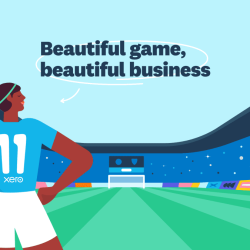Why does attention sit at the top of the marketing funnel?
Simple — because going unnoticed is a surefire way to be forgotten. Brands and advertisers have grappled with this problem for years, trying to find a way to cut through the noise and drive engagement and conversion rates. Unfortunately, the landscape has become saturated, with too much content and channels, making it increasingly difficult to secure consumers’ attention. And it’s not just a fragmented ecosystem that’s posing a challenge. Economic pressures and the constant need to demonstrate return on investment (ROI) leave advertisers desperate to get their strategies spot-on.
Moreover, 57% of B2B marketers acknowledge their struggle to create relevant content for their respective audiences. So, where does this leave your brand in the bid to win the attention game? For a start, you’d do well to shift away from the tried-and-tested search and social ads.
Broadening your horizons and adopting long-term, sustainable strategies like multi-channel advertising and contextual solutions across modern channels like CTV, DOOH, audio, and gaming would go a long way in resolving the effectiveness crisis.
Building buyer personas and mapping the customer journey
Capturing your audience attention is nigh-on impossible without first getting to know them. Building generalised representations of the ideal customer for each product or service is the first step to truly understanding them and their marketing journey. There are many more decision-makers in a B2B buying process than in a B2C buying process. In B2C, the customer is looking for a particular item or encounters one they hadn’t considered before and decides to either make a purchase or not.
This shows that media buying isn’t very straightforward in the B2B space, with multiple stakeholders involved in the decision-making process. Expect an average of five people to make their voices heard, ranging from junior researchers to senior leaders. This is where buyer personas make the difference.
By creating buyer personas, B2B marketers can develop a comprehensive understanding of their audience. Accurate buyer personas help refine messaging and targeting and enhance the effectiveness of marketing strategies. These will be powerful assets when creating a map of the customer’s buying journey to determine where ads will be most effective, ensuring decision-makers’ attention is captured at the right moment to increase conversion chances.
Curate the right media mix
From traditional channels such as radio and TV to slightly more advanced options including social media, digital out-of-home (DOOH) and gaming, there’s no shortage of platforms vying for consumers’ attention. But none of these things are quite like the other.
The bottom line is that there isn’t a one-size-fits-all strategy that will work across all channels. Each channel has its own unique advantages. Instead, the onus is on advertisers to adopt a multi-channel approach — the key to unlocking a larger, more targeted audience. This is because it can drive a symbiotic relationship with all the channels. Consider how content works on each one and properly combine them into a formidable marketing strategy taking every part of the funnel into account.
Research from eMarketer shows that 73% of professionals prefer to learn about a product or service from a short video. This offers marketers the opportunity to use interactive display ads to capture user’s attention at first instance, then use video ads to showcase product features and benefits in action and finally leverage DOOH ads to reach professionals during their daily commute.
This strategy shows how marketers can gain B2B audience attention and push the lower down the funnel to the evaluation and decision stage, where they can then leverage last mile content like testimonials and white papers to move prospects closer to conversion.
Targeting first, then re-targeting
Despite Google’s announcement that it is no longer moving forward with the deprecation of third-party cookies, the reality is that marketers continue to face challenges with how to target deterministic audiences with available data effectively. Fortunately, a number of tactics — including behavioural, geographic and contextual targeting — will continue to remain effective across programmatic channels.
Addressable B2B audiences (demographic, B2B-persona, account-based) will rely on techniques including user authentication and interoperable alternative identity standards in the future. The strength of programmatic lies in its flexibility. Marketers can use third-party data to reach a set of users that fit a brand’s ideal customer profile (ICP) who have not yet seen a campaign or found a website organically but also, more importantly, leverage first-party data to engage with customers who have already engaged with the brand in some way, shape or form and re-target them further down the funnel.
WordStream reports that customers are 70% more likely to convert after viewing an ad from a re-targeting campaign. This highlights the importance of effective curation of audiences to drive users back to a site and what channels best support this strategy. For context, while CTV is a useful channel for demand generation due to its format, display is an effective tool to engage an already-engaged user with a captivating call-to-action hence making it a better channel for a re-targeting campaign.
Contextual targeting is also a useful strategy for re-targeting campaigns as it ensures that relevant ads are displayed alongside content that directly relates to the content that the consumer is currently viewing or interested in, increasing the likelihood of engagement and, ultimately, conversion.
It all works together
Capturing and retaining consumer attention in today’s fragmented and content-saturated landscape is more challenging than ever. However, through effective programmatic advertising, leveraging detailed buyer personas and a well-curated media mix, B2B marketers can precisely target and engage their audience.
This includes using data-driven insights and location and contextual targeting across multiple channels such as CTV, display, native ads, and programmatic audio. This approach not only maximises reach and engagement but also ensures that the right people see ads at the right time, driving conversions and ultimately justifying marketing investments.
Featured image: Pineapple Supply Co. / Pexels



































